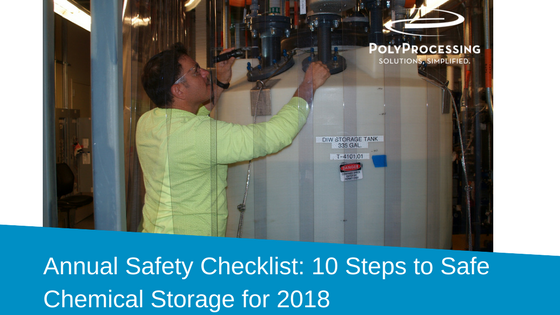Annual Safety Checklist: 10 Steps to Safe Chemical Storage for 2018

Get ready to kick off 2018 safely! Every polyethylene chemical storage tank, regardless of its age, should be inspected at least once a year. Conducting a careful and thorough visual inspection assures the safety of employees, protects the integrity of the chemicals stored, and helps extend the life of the tank.
Follow these 10 steps to make sure your tank is ready for another year of safe storage:
 First, you need to empty the tank -
First, you need to empty the tank -
Any chemical residue must be neutralized.- Clean both the exterior and interior of the tank - A dirty tank cannot be properly inspected.
- Conduct a visual examination of both the exterior and interior - Check for any cracking, crazing, or signs of a brittle appearance.
- Pay special attention to important areas - Double check areas around fittings and “corners”, such as where the dome connects to the sidewall and where the sidewall and bottom meet.
- If you are unable to enter the tank? - If on-site constraints or safety do not permit entry into the tank, use a bright light to carefully inspect the interior of the tank. Keep in mind, stress cracks begin to first appear on the interior of the tank. Before you do this, ensure that the chemical stored does not have a low flash point before attempting use of a high powered light.
- Inspect non-chemical contact areas - Remember, chemical fumes can cause oxidation to the areas that never come into contact with the tank, including the dome.
- Don't forget to examine all fittings, hoses, and gaskets - Check for signs of leaks, cracks, or any deterioration on all fittings, hoses, gaskets, or other accessories.
- Vents and fume scrubbers - Inspect vents and scrubbers to assure proper venting to eliminate pressure and vacuum. Make sure the end of scrubber piping is never submerged in more than 6 inches of liquid.
- Over-pressurization from tank filling - Make sure tank filling is not resulting in “ballooning” of the tank.
- Inspect your secondary containment choice - Make sure the secondary containment vessel is appropriate for the chemical being stored, large enough, and in good condition.
If any signs of stress cracking, crazing, or brittleness are discovered, the tank may need to be replaced to prevent failure.
Finally, here are a few words of warning:
Be safe when conducting the annual chemical storage tank inspection. Harmful chemical fumes can emit from the manway opening, or exist in confined spaces. Use proper protective equipment and inspect with caution. Also, use proper lift equipment, always utilize fall protection and do not stand on the top of the tank as there is no load rating for a polyethylene tank dome.
If you don't feel comfortable tackling this on your own, did you know that Poly Processing Company has a nationwide field service team? Hiring the Poly Processing Field Service team for tank inspections can reduce the expenses the tank owner may encounter on extend the life of the tank beyond 15+ years.
Service team members can install new fittings and gaskets. Tank samples can be tested to ensure the tank integrity is still intact. If you’re changing the chemical being stored, Poly Processing Field Service can ensure that your tank is compatible and if compatible, correctly fitted for the new chemical.
If you have any questions regarding annual tank inspection or if you'd like to schedule a service call for a tank inspection, please contact a chemical storage tank expert.
- December 5, 2017
- Topics: Value Added
About Poly Processing
Posts By Topic
Tech Talk Podcast Episodes
Subscribe By Email
Recent Posts
- OR-1000™: Next Generation System for Oxidizing and Corrosive Chemical Storage
- Protect Your Facility and Your Bottom Line with a Chemical Leak Detection System
- PPC Installation, Operation, and Maintenance Manual: Ensure Tank Longevity
- How To Use The Chemical Resistance Guide
- Better and Safer Alternatives to Downpipes
Tank Configurator

Find the recommended tank and system components for your chemical storage challenge.
Configure a Tank Package


